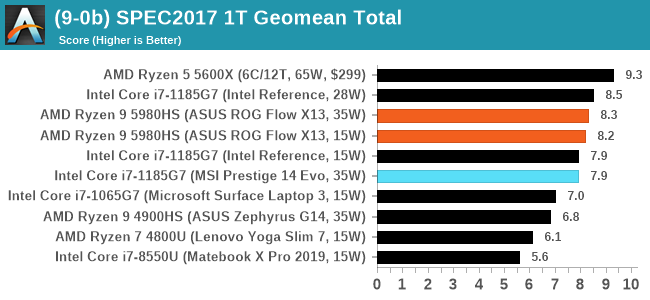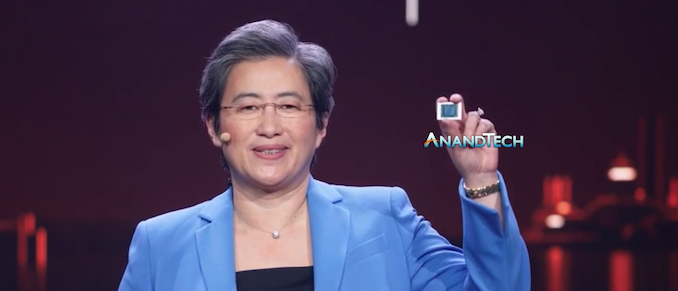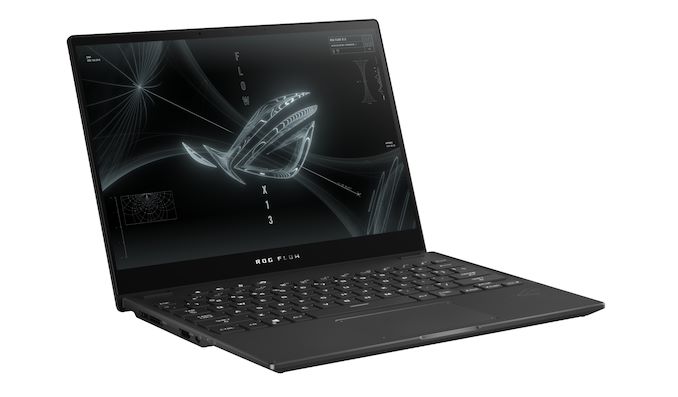AMD Ryzen 9 5980HS Cezanne Review: Ryzen 5000 Mobile Tested
by Dr. Ian Cutress on January 26, 2021 9:00 AM EST- Posted in
- CPUs
- AMD
- Vega
- Ryzen
- Zen 3
- Renoir
- Notebook
- Ryzen 9 5980HS
- Ryzen 5000 Mobile
- Cezanne
Focusing on Premium Experiences
The issue with AMD’s notebook strategy through the 2010s was that most users saw the brand as a budget implementation, with low performance and low specifications. Both AMD and its OEM partners were complicit in assisting this projection, using 1366x768 TN screens and slow mechanical hard drives. There were a number of negative feedback loops preventing a nice AMD mobile system from hitting the market, and the only key design wins were from mass corporate sales. With the launch of the first Ryzen Mobile towards the end of the decade, AMD finally had a performance product worthy of attention, and the company has had a steady improvement generation-on-generation, convincing its OEM partners to come along and take advantage of the performance uplift for their customers.
AMD’s historic lows in that 2010 decade were performance, specifications, and battery life. With Ryzen 4000 Mobile, from last generation, AMD had a product that could dispel all those assumptions, and we saw critical acclaim put upon devices like the Lenovo Slim 7 Yoga, and the ASUS Zephyrus G14. From our review of the new generation today, Ryzen 5000 Mobile, the whole strategy that AMD is playing has finally come into focus.
AMD stated that the new generation Ryzen 5000 Mobile processors were in the lab and up-and-running only two months after Ryzen 4000 Mobile launched. AMD made both sets of processors pin-compatible, allowing OEM partners to build designs that could be used for either processor family. The key here that I’ve realized is that AMD’s ultimate goal with these was to build a strong Ryzen 5000 Mobile family, and Ryzen 4000 Mobile was an option for partners to take baby steps, but the main goal was Ryzen 5000, with Zen 3. AMD’s statement of already having over 150+ system designs in the works with Ryzen 5000 Mobile, another +50% over the previous generation, along with this strategy of having a regular predictable cadence of products through re-use of different hardware elements showcases why Ryzen 5000 Mobile is important to the company. With AMD’s recent supply issues as well, we’re of the opinion that AMD has been stockpiling these Ryzen 5000 Mobile processors in order to enable a strong Q1 and Q2 launch of the platform with stock for all OEMs.
What we tested today is one of the AMD flagships for launch, the Ryzen 9 5980HS inside the ASUS ROG Flow X13. This is a sub-16mm ultraportable gaming laptop with a mid-range discrete GPU installed, an impressive 4K 16:10 Pantone certified IPS display, 32GB LPDDR4X memory and a 1 TB NVMe SSD. It also has an executive feel and design, indicating that both AMD and ASUS want to take this platform to its most premium customers. We’re leaving a full review of the laptop itself for a later date, let us focus on the performance of the processor inside.
The jump from Zen 2 to Zen 3 in the mobile space for AMD is more than just putting in the new cores. The cache adjustment from a split 4+4 MB L3 cache to a unified 16 MB L3 cache enables a better effective latency and less reliance on constantly going out to main memory – AMD is also aggressive on the L3 prefetching policies to drive performance. We can see that the single 8-core CCX has low core-to-core communication latency showcasing that enthusiast level workloads will benefit in more ways than one.
AMD is also piling on improvements to help with power, such as enabling different per-core voltage levels and a more efficient memory controller. Per-core voltage control is something that every modern CPU has to have (or at least islands of CPUs) in order to get the best battery performance. AMD is pairing this with its CPPC2 support, and users will benefit from very quick idle-to-turbo performance for immediate responsiveness.

For our benchmark suite, almost all of our benchmarks show an uplift for the new Ryzen 5000 Mobile series, some considerably so: our compile benchmark is +12%, Corona rendering is +18%, Dolphin emulation +17%, NAMD +8%, Blender +6%. To our surprise our SPEC2006 1T benchmark is +32%, accelerated considerably by the 16 MB L3 cache, but also because these CPUs also support a higher instantaneous power turbo modes than the previous generation. This enables some competitive performance numbers against Intel’s Tiger Lake platform in single thread focused tests (AMD wins on multithread quite easily).
All of these core updates, as well as design wins enabling better hardware under the hood, put AMD’s Ryzen 5000 Mobile series in good stead to power a generation of machines especially as more and more of us work from home. When Intel was in a period of high demand through 2018 and 2019, Intel focused on premium solutions to make the most revenue - Intel’s financials last week showed that the company was selling more and more education-focused low-end notebooks and Chromebooks, now that demand had reduced. We can apply something similar to AMD's current situtation - AMD’s silicon is in high demand for 2021, and so AMD’s target this year would appear to be more mid-range, premium commercial, and enthusiast machines. To reaffirm this, AMD has also promised that we will see notebooks this year paired with the most powerful mobile graphics cards, enabling high-performance gamers to move to AMD. No doubt we will have a number pass through our hands through the year, especially as they hit the shelves starting February.












218 Comments
View All Comments
Meteor2 - Thursday, February 4, 2021 - link
Great point.ikjadoon - Tuesday, January 26, 2021 - link
It's great to see AMD kicking Intel's butt in a much larger market (i.e., laptops vastly outsell desktops): AMD really should be alongside, or simply replacing, Intel in most premium notebooks. Gaming notebooks are not my cup of tea, but glad to see for upcoming 15W Zen3 parts.Will we see actual, high-end Zen3 notebooks? Lenovo, HP, ASUS, Dell: for shame if you keep ramming toasty Tiger Lake down customers' throats. Lenovo's done some great offerings with both AMD & Intel; that means some compromises with notebook design (just go all AMD, man; if/when Intel is on top, switch back!), but beefier cooling for Intel will also help AMD.
Still, overall, I don't see anything convincing me that x86 is really right for notebooks, either. So much waste heat...for what? The M1 has rightly rejiggered expectations: 20 hours on 150 nits should be ordinary, not miraculous. Limited to no fan spin-up and max CPU load should yield a chassis maximum of 40C (slightly warmer than body temperature). And, all the while with class-leading 1T performance.
As this is a gaming laptop, it's not too relevant to compare web benchmarks (what most laptops do), but this is peak Zen3 mobile and it still falls quite short:
Speedometer 2.0
35W Ryzen 5980HS: 102 points (-57%)
125W i9-10900K: 119 points (-49%)
35W i7-1185G7: 128 points (-46%)
105W Ryzen 5950X: 140 points (-40%)
30W Apple M1: 234 points
You can double / triple x86 wattage and still be miles behind M1. I almost feel silly buying an x86 laptop again: just kilowatts of waste heat over time. Why? Electrons that never get used, just exhausted and thrown out as soon as possible because it'll throttle even worse otherwise.
undervolted_dc - Tuesday, January 26, 2021 - link
because you here are benchmarking javascript engine in the browserbut not being enough you are comparing those in single thread so here you are comparing 1/16 of the 5950hs vs 1/4 of the m1
a 128core epyc or a 64core threadripper probably will be even worse in this single threaded benchmark ( because those are levaring threads and are less efficient in single threaded app )
if you like wrong calculations then 1 core of the 15w version use less tha 1w for what result ? ~ 100 points ? so who is wasting electrons here ?
( btw 1 core doesn't use 1/16 because there are boosts , but it's even less wrong than your comparison )
ZoZo - Tuesday, January 26, 2021 - link
128-core EPYC? Where?His comparison is indeed misleading in terms of energy efficiency, but it's sad that no x86 is able to come even close to that single-threaded performance.
WaltC - Tuesday, January 26, 2021 - link
Doubly sad for the M1 that we are living in the multicore/multithread era...;)ikjadoon - Tuesday, January 26, 2021 - link
The energy efficient comparisons are pretty clear: the best x86 (Zen3) has stunningly lower IPC than M1, which barely cracks 3 GHz. The only way to make up for such a gulf in IPC is faster clocks. Faster clocks require the 100+W TDPs so common in high-performance desktop CPUs. It's why Zen3 mobile clocks so much lower than Zen3 desktop (3-4 GHz instead of 4-5 GHz)A CPU that needs 3x power to do the same work (and do it slower in most cases) must exhaust an enormous amount of heat, when considering nT or 1T benchmarks (Zen3 requires ~20W for 5 GHz boost on a *single* core). Look at those boost power consumption measurements.
Specifically in desktops (noted in my comparison about tripling TDP...), the CPU *alone* eats up an extra 60 to 90 watts during peak usage. Call it +20W average continuously, so we can do the math.
20W x 8 hours x 7 days a week = +1.1 kWh excess exhaust heat per week. x86 had two corporate giants to do better. It's been severely litigated, but that's Intel's comeuppance. If Intel can't put out high-perf, high-efficiency x86 architectures, then people will start to feel less attached to x86 as an ISA. x86 had billions and billions and billions of R&D.
I see no reason for consumers to religiously follow x86 Wintel or Wintel-clones in laptops especially, but desktops, too: where is the efficiency going to be coming from? Even if Apple *had flat 1T* for the next three years, I'd still feel more optimistic about M1-based CPUs in the long-term than x86.
Dug - Tuesday, January 26, 2021 - link
"I see no reason for consumers to religiously follow x86 Wintel or Wintel-clones in laptops especially, but desktops, too: where is the efficiency going to be coming from?"Software, and getting work done. M1 is great and all, but just need to convince the boss that Apple or 3rd party has software available for our company....... Nope, oh well.
Other negatives-
For personal use, people aren't going to spend thousands of dollars to get new software on new platform.
They can't play games (or should I say they can't play a majority), which is probably the largest market.
They can't change anything about their software
They can't customize anything.
They can't upgrade any piece of their hardware.
They don't have options for same accessories.
So I'll go ahead and spend the extra $15 a year on energy to keep Windows.
Spunjji - Thursday, January 28, 2021 - link
"A CPU that needs 3x power to do the same work"It doesn't. It's been demonstrated a few times now that if you scale back Zen 3 cores to similar performance levels to M1, M1's perf/watt advantage drops to about 30%. It's still better than the node advantage alone, but it's not crippling, and M1 is simply not capable of scaling up to the clock speeds required to match x86 on desktop / HPC workloads.
They're different core designs matched to different purposes (ultra-mobile first vs. server first) and show different strengths as a result.
M1 is a significant achievement - no doubt about it - but you're *massively* overstating the case in its favour.
GeoffreyA - Friday, January 29, 2021 - link
Thank you for this.Meteor2 - Thursday, February 4, 2021 - link
"M1 is simply not capable of scaling up to the clock speeds required to match x86 on desktop / HPC workloads" ...Yet. In a couple of years x86 will be behind ARM across the board.Fastest HPC in the world is ARM *right now*. Only the fifth fastest is x86.